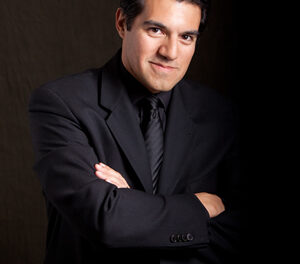A theatre company and a script are both put to the test when a play production follows close on the heels of another company’s successful production of the same work. With the new Warehouse Performing Arts Center’s production of John Logan’s Red, not quite two years have passed since the nearly flawless Metrolina area premiere staged by Actor’s Theatre of Charlotte. More interesting perhaps than the face-off between the two sets of protagonists – abstract expressionist titan Mark Rothko and young apprentice gofer Ken – is what happens when Logan’s script is scrutinized for a second time. Do the drama and excitement seem as firmly grounded and convincing when we can recall the twists just before they happen again? Are the ideas less compelling when we examine them more closely? And perhaps the keenest test – has the script exhausted its visceral and intellectual cargo the first time around or can it reload its impact and tell us more? Presented at the Warehouse’s intimate 55-seat storefront theater in Cornelius and directed by Melissa Ohlman-Roberge, the key moments detonated powerfully late in the action when both actors, Kevin Roberge and Austin Larkin, delivered their climactic monologues.
Rothko is at a very turbulent point when we first encounter him. He is in the midst of completing the most prestigious commission of his career from architects Philip Johnson and Mies Van der Rohe, who have picked him to paint a series of murals for the posh Four Seasons Restaurant in the new Seagram Building on Park Avenue. But the $35,000 commission comes at a time when a new generation of Pop artists is getting set to take Rothko down from his pedestal – just as he and Jackson Pollack had done to Picasso and Matisse a generation earlier. Ken is witness to both the arrogance and weakness of Rothko as he stares endlessly at his own works-in-progress, chain smokes, guzzles booze, expounds eloquently on his art, berates his enemies and critics, and – in spasmodic fits – actually paints. Rothko makes it clear that he will be Ken’s employer, not his mentor and certainly not his rabbi or surrogate father. Yet it’s inevitable, over months and years of toiling side by side in his studio, that Rothko will open up to his apprentice and get to know him better.
Roberge usually performs on big stages in musicals and at times appeared uncomfortable on opening night having the audience so close, yet the role of Rothko is well within his range. Last summer, he was Julian Marsh in 42nd Street, relentlessly prodding Allentown wunderkind Peggy Sawyer to stardom, and three summers ago, he was Wilbur Turnblad in Hairspray, eclipsed by his precocious daughter and his massive wife. Elements of both of those performances resurfaced here, particularly the fiery Marsh, which I occasionally found underpowered on the larger Davidson College stage. Whether he has consciously worked on toughening his persona or merely benefited from a smaller venue that he can more easily overpower, the steeliness of Roberge makes for a riveting Rothko when he has his lines firmly in command. As the run continues, Roberge will no doubt summon up more power and momentum as his difficulties dissipate. Rothko’s more vulnerable moments of contemplation and self-doubt already have a compelling immediacy.
Larkin has more youth on his side than Jeremy DeCarlos did when he played Ken in 2012, and the offhand rabbi remark leads me to believe that he’s more what Logan had in mind racially. But while he stands up to Rothko beautifully in the denouement, I didn’t find Larkin quite as attuned to Ken’s personal growth or the complexities of his developing relationship with the renowned painter. Ohlman-Roberge works meticulously with both actors, and a few more like her will help refine Larkin’s obvious talents in the years ahead. It was largely Larkin’s initiative that made this production happen, according to Warehouse Artistic Director Marla Brown’s curtain speech, so there can be little doubt of his eagerness to learn. Lisa Altieri’s set design, including numerous faux Rothkos in progress, accentuates the authenticity of the unfolding drama, with KC Roberge deftly at the light board.
What’s missing in the chemistry between Rothko and Ken is more than counterbalanced by the profundity of what they have to say. Together they revisit the mysterious dichotomy and interplay between the Dionysian and the Apollonian elements in art as expounded by Nietzsche in The Birth of Tragedy, but they go just as deeply into the personal symbolism of red and black in Rothko’s work and his life. But it isn’t all words and rants. There is an ecstasy as the two painters spontaneously improvise on all the manifestations of the color red, which eventually serves as a prelude to the episode where they finally prime a canvas together in the color of dried blood. It’s all timed perfectly to an allegro movement of classical music, so when the music and the painting concluded at almost the same instant, the audience couldn’t help breaking into applause as the two men stood there panting.
So does the 2010 Tony Award- and Drama Desk-winner for Best Play reward repeated viewings? Yes, indeed. Three days after Robin Williams’ suicide, the glimpse into Rothko and his personal demons – which eventually resulted in his suicide – seemed to be a timelier study the second time around.
Red continues through Saturday, August 23. For more details on this production, please view the sidebar.











